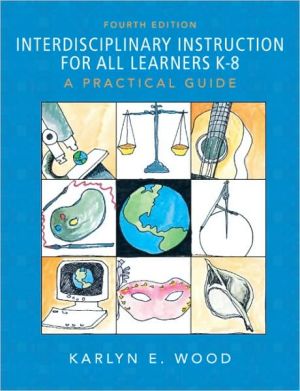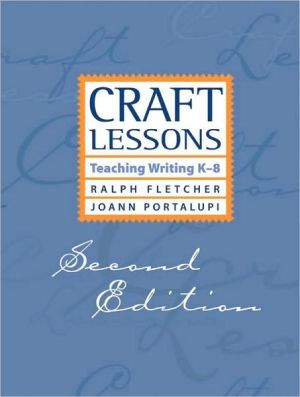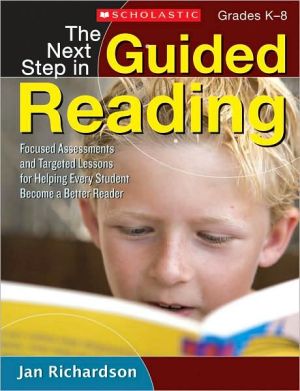Interdisciplinary Instruction for All Learners K-8: A Practical Guide
**ADVANCE COPY**\ Interdisciplinary Instruction: A Practical Guide for Elementary and Middle School Teachers\ Karlyn E. Wood, State University of New York College at Old Westbury\ "Wood's approach to interdisciplinary instruction is comprehensive and practical. Not only is there a strong theoretical foundation laid out for the reader, but also there are helpful step-by-step procedures for creating and implementing an interdisciplinary approach to instruction. Wood provides a rationale for...
Search in google:
Every K-8 teacher should have a copy of Interdisciplinary Instruction for All Learners K-8 on their desk. This brief practical guide provides classroom teachers with a step-by-step guide to planning, designing, creating, and implementing interdisciplinary instruction for all learners. Now following the backward design process, the text also provides teachers with outlines for planning interdisciplinary and multidisciplinary units.The author uses lesson plans that are familiar to elementary and middle school teachers and all of the lesson plans follow five specific planning protocols. Each protocol is then explained in a step-by-step manner and teachers are given numerous opportunities to practice creating their own lesson plans. By the end of the book, teachers will have experienced the entire process involved in planning for and implementing the interdisciplinary method in the classroom.
Preface xTo the Reader xivAbout the Author xv1 Introduction to Interdisciplinary Instruction 1Overview 1Distinguishing Features of the Interdisciplinary Approach 2Comparing Interdisciplinary, Multidisciplinary, and Integrated Instruction 2Interdisciplinary and Multidisciplinary Studies: Their Organization and Design 5Using the Skills, Techniques, and Ways of Knowing in Applicable Academic Disciplines 6Emphasis on Process and Content 7Differentiation of Student Investigating and Reporting Alternatives 8The Rationale for Using Interdisciplinary Instruction for Diverse Learners in Elementary and Middle Schools 9Learner Diversity and Multiple Intelligences-Theories of Sternberg and Gardner 10Social Interaction: Theories of Piaget and Vygotsky 12Support from Research on the Human Brain 13Benefits to Our Diversity of Learners and Students with Special Needs 14The Use of Multiple Sources of Information 14Meaningful Applications of Ways of Knowing and Skills in the Academic Disciplines 15Summary 16Activity 16References 17Suggested Readings 192 Requirements and Challenges of Interdisciplinary Instruction 21Overview 21Implementing Interdisciplinary Instruction: Requirements of Teachers 22A Compatible Educational Philosophy 22General and Child Development Knowledge 22Classroom Management Skills 23Lesson and Unit Planning Skills 25Skills in the Application of Technology for Interdisciplinary Instruction 26Collaboration with Others in the School Community 28Challenges To the Development of Interdisciplinary Programs 30Reluctance to Change 30No Child Left Behind Legislation 31System Support33Materials and Equipment 33The Need for Parent and Community Involvement 34Lack of Adequate Research 35Summary 35Activity 36References 36Suggested Readings 373 Designing Interdisciplinary Units 40Overview 40Introduction to Interdisciplinary Unit Planning 41Student Involvement in the Planning Process 41Encouraging Students to Develop a Variety of Abilities 41The Context for Learning: The First Consideration in Planning for Instruction 42Cognitive Development: Levels and Abilities 42Interdisciplinary Unit Plan Outline and Design 44Determining the Topic, Theme, or Problem of the Unit 47Determining the Unit General Objectives 49Determining the Unit Content Learning Standards 50Preparing the Essential Questions of the Unit 50Preparing the Unit Assessment Plan 51Preparing the Unit Learning Plan 51Listing the Unit Materials 60Summary 63Interdisciplinary Unit Plan Example 63Activity 75References 75Suggested Readings 764 Designing Multidisciplinary Units 77Overview 77Introduction to Multidisciplinary Unit Planning 78Multidisciplinary Unit Plan Outline and Design 79Considering the Context for Learning 80Selecting a Topic, Theme, or Problem 81Determining the Unit General Objectives 82Determining the Unit Content Learning Standards 82Preparing the Essential Questions of the Unit 83Preparing the Unit Assessment Plan 83Preparing the Unit Learning Plan 84Listing the Unit Materials 86Multidisciplinary Unit Plan Example 87Activity 94References 95Suggested Readings 955 Lesson Planning Strategies for Interdisciplinary Instruction 97Overview 97Learning and Developmental Principles for Lesson Planning 98Using Bloom's Taxonomy to Determine the Cognitive Levels of Instruction 100Level 1 Knowledge 101Level 2 Comprehension 101Level 3 Application 101Level 4 Analysis 102Level 5 Synthesis 102Level 6 Evaluation 102Lesson Plan Formats Used for Interdisciplinary Instruction 102Learning Standards, General Objectives, Key questions, and Behavioral Objectives 104Learning Standards and General Objectives 104Key Questions 106Behavioral Objectives: Short-Term Goals 106The Lesson Plan Procedure 107Critical Elements in the Procedure Section of a Lesson 107Other Considerations for Planning the Lesson Procedure 111Protocols for Planning Some Lesson Procedures 112A Protocol for Guided (Directed) Reading Instruction 112SQ3R: The Survey, Question, Read, Recite, Review Protocol for Independent Reading 117A Protocol for Guided Listening 117A Protocol for Guided Viewing 120KWL: The Know, Want to Know, Learned Protocol 123A Protocol for Skills Instruction: The Five-Step Lesson 128The Scientific Method of Investigation: A Protocol for Some Lessons in Science 131Other Procedures 134Summary 134Activity 134References 136Suggested Readings 1376 Assessment Planning for Interdisciplinary Instruction 139Overview 139Assessment and Interdisciplinary Instruction 140The Purposes of Assessment 141Assessment Techniques: The Need for Variety 141Using Authentic Assessment Techniques With Interdisciplinary Instruction 142Using Rubrics With Interdisciplinary Instruction 144Using Examinations With Interdisciplinary Instruction 146Common Test Scores 146Assessment Concerns: Validity and Reliability in Testing 146Writing Valid and Reliable Test Items 148Summary 153Activity 153References 153Suggested Readings 154Appendix 156Index 172








